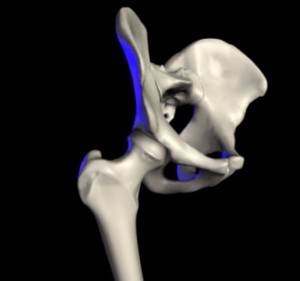The hips are a common location of pain and dysfunction, but is it really your hip that is causing the problem?
While there are many hip disorders directly related to the hip joint, it may not be your hip that is the cause of your pain and dysfunction. Several large structures such as the lumbar spine, pelvis or thigh are closely linked with the hip and if dysfunction is present in this area, pain can be referred back towards the hip, leading people to believe the problem originates in the hip.
Hip pain is a common complaint that has a variety of causes. The hip, is one of the main weight bearing joints in the body with the main role of creating stability within the lower body during static and dynamic postures.
Hip pain can have a quick onset suggesting an acute condition or can have an insidious onset of pain, which will indicate a more chronic condition. As a weight-bearing joint, it is commonly affected by degenerative changes over time. Whilst involving the same area, acute and chronic conditions are treated very differently and will have different recovery time and rehabilitation programs.
Studies have shown that hip pain is more prevalent in older populations, with 14.3% of people over 60 years of age reported significant hip pain in the US. Despite this figure, many young people suffer from hip conditions too, but are usually of a different cause.
When assessing the hips, there are many possible causes of dysfunction, and finding the exact location of the pain and noting any aggravating or relieving factors is essential in finding the correct diagnosis.
Conditions of the Hips
ACUTE
Fracture
Dislocation
Acute bursitis
Tendinitis
Referral from other structures;
low back, pelvis, pubis Tumours
Labral tear
Transient Synovitis
CHRONIC
Osteoarthritis
Femoroacetabular Impingment (FAI)
Chronic bursitis
Rheumatoid arthritis
Tumours
Snapping hip
The conditions mentioned above are specific to the hip joint. There are many structures that cross the hip or that can refer pain to the hip.
The Iliopsoas is a large muscle that can cause problems that mimic hip pain. It is the main culprit for a snapping hip and when very tight can add to lumbar spine and sacroiliac dysfunction. Although this muscle refers pain to the hip area, in many cases the hip is not the cause of the dysfunction.
Problems involving the sacroiliac joint, the pubic symphysis or the facets (small joints) in the lumbar spine can also refer pain to the hip. Whether these problems are acute or chronic, they will have muscle involvement. When a muscle is involved in an injury it has a pain referral pattern, and many of the muscles surrounding the hips, low back and pelvis refer pain to the hip.
Some signs and symptoms of hip dysfunction include; restricted range of movement, pain on weight bearing or non-weight bearing, swelling, bruising, inflammation or any visible deformities. In several cases the hip may not be the primary cause of injury and it is therefore essential to assess the lumbar spine, sacroiliac joints, pubic symphysis as well as all soft tissue structures surrounding the hip. Therefore a full body assessment is essential in order to arrive at a proper and thorough diagnosis.
A full assessment would include inspection of the hip, low back and pelvis, testing the range of motion of each joint. In addition to the joints, all muscles should be tested, not only for the reproduction of any pain, but to assess for inactive/overactive muscles, which can change the biomechanics of the lower body. There are many orthopaedic tests that can be performed to narrow down the involved area.
If further testing is required, clients can be referred for X-ray, Ultrasound or MRI imaging. X-rays will help in the diagnosis of osseous involvement such as fractures, osteoarthritis or more serious conditions like any tumours, where as ultrasounds and MRI’s target the soft tissue as well as the bones and joints and are sometimes vital in diagnosis of tendinopathies, bursitis and labral tears.
A good treatment plan and rehabilitation program is essential for a full recovery with hip problems. If not treated, hip disorders can change from acute to chronic and over time alter the proper biomechanics of the low back and lower limbs which will create more complex long term problems.
The treatment for any hip condition will differ depending on the diagnosis, age of the patient, severity of the pain and dysfunction. Whilst there are some hip conditions that are more common than others it is recommended to seek professional assessment in order to start on the correct path to recovery.
Whilst pain is the most common presenting symptom regarding hip complaints, dysfunction is usually present long before the pain arises. Dysfunction may present itself as a decrease in range of motion or decreased hip or leg strength.
Pain is usually the last symptom to show when there is a hip problem. For this reason it is recommended to get checked by a chiropractor when you first notice any symptoms or even better, go for regular checks to make sure your hips and low back are working at the optimum level as a preventative measure.
If you would like more information or would like to book an appointment at Neurohealth Chiropractic – please call the clinic on 9905 9099 or email us admin@neurohealthchiro.com.au or fill in the contact form from our website www.neurohealthchiro.com.au
Sign up to receive Neurohealth Chiropractic’s Free monthly health newsletter on the Right Hand Side of this page. Filled with great information and lots of easy health tips to keep you at Optimal Health!




